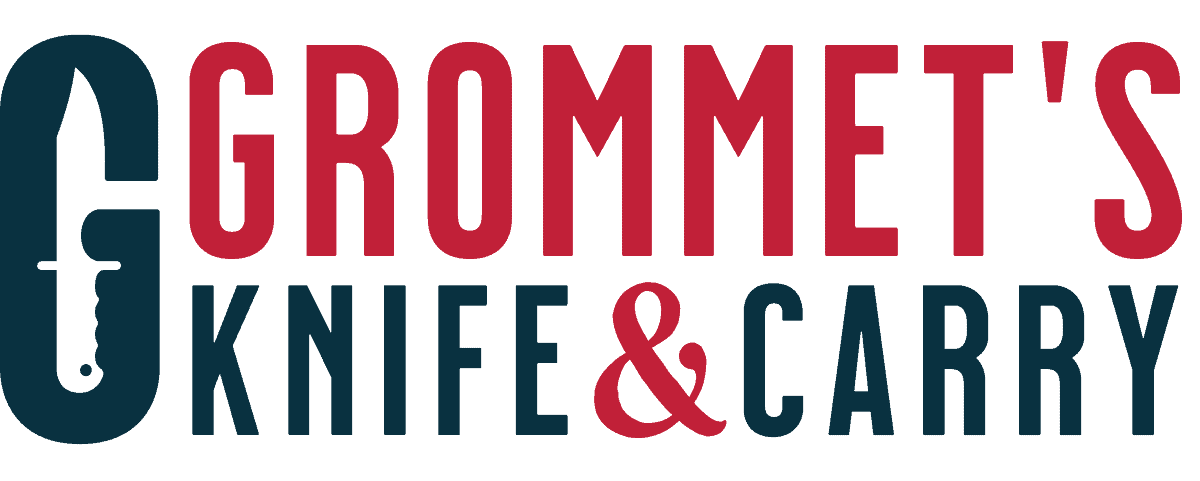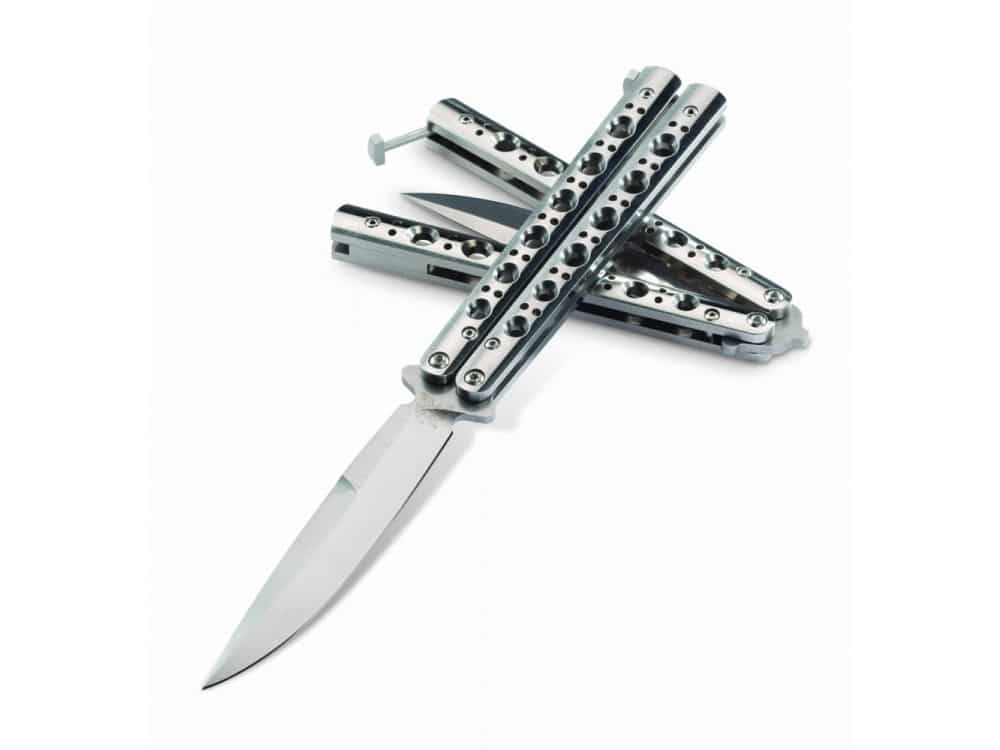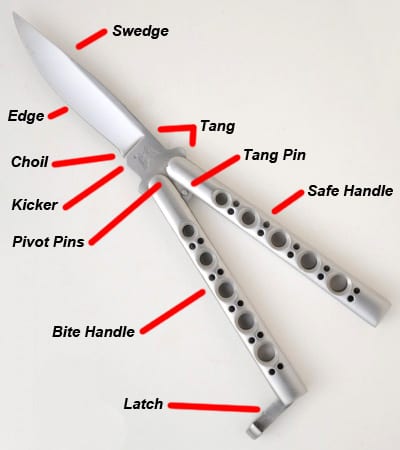One of the simplest balisong tricks is Fanning. To perform this trick correctly and safely, you must do the following:
- Take the knife by the safe grip,
- Lower the blade and fold your fingers in a tube shape so that your thumb and forefingers hold the blade and the handle hangs freely between your other three fingers and the brush,
- Rotate the knife in any way that is convenient for you,
- To return to the starting position, try to grasp it the moment the handle is above your hand and then slow its movement. Then the knife will automatically close
Many users are familiar with a type of knife whose handle is divided into two parts between which the blade is hidden when in a closed position. This is called a butterfly knife. Such a cutting tool owes its name to the beautiful shape that appears when it rotates, as it resembles the movement of butterfly wings.
Despite its controversial origins, the balisong, or sometimes called the batangas knife, is a pocket knife that every knife store aficionado craves! Especially for martial arts enthusiasts and Jackie Chan fans.
Indeed, once you know how to use a butterfly knife correctly, you will be able to perform impressive tricks worthy of a Filipino warrior. Discover in this article the history and the structure of the butterfly balisong knife, and learn how to handle it properly.
Visit Grommet’s Cutlery to get a real butterfly knife and start practicing!
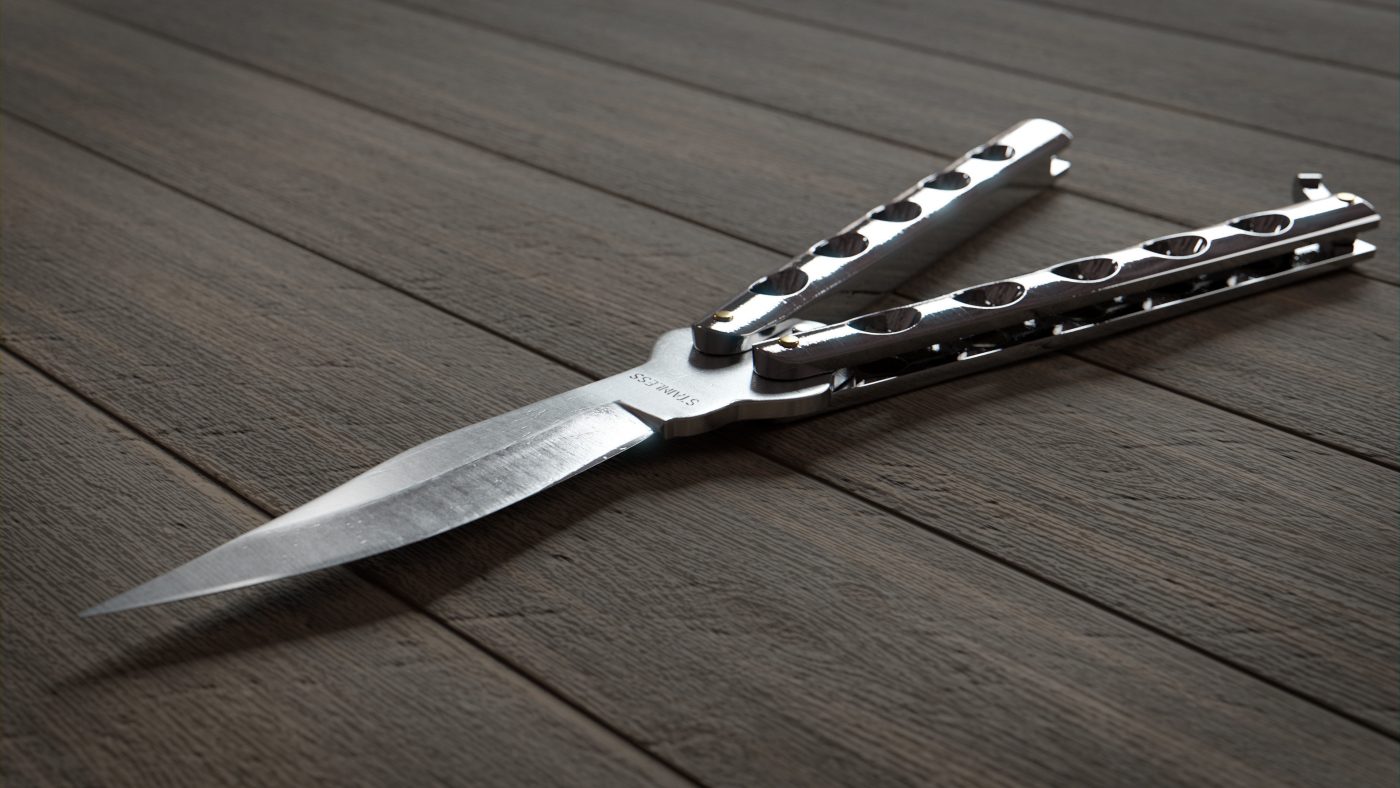
What is a butterfly knife?
The balisong is better known under the name butterfly knife referring to its two mobile branches which allow it to be opened and closed with only one hand. It can be considered a type of switchblade knife.
In cutlery, the design of the butterfly knife allows multiple opening and closing possibilities, from basic manipulations such as forward and backward rotations to complex sequences and combos. It’s known for its unique butterfly knife tricks.
This is a folding knife like these, and it was created for military use alongside other bladed weapons like swords and other deadly weapons like guns. It’s still a dangerous weapon to this day, often cited as a weapon for self defense.
It has a knife blade divided into two mobile branches that can be manipulated with speed. This knifetype opens easily with one hand and is indeed a very useful self-defense tool. However, it should be handled with caution if you don’t want to cut off a finger! A practice butterfly knife might be a good option for a first-time user.
Remember that some jurisdictions may consider the butterfly knife illegal as a concealed weapon, so check out local knife laws and exercise legal caution like you would with any sharp knife, gravity knife,or automatic knife.
The butterfly knife is found in some Philippine martial arts such as Kali-Arnis, and with mastery its handling becomes impressive! Note that there are butterfly knives of all sizes, shapes, and prices ranging from the low-end model to the rarest ones hitting hundreds of dollars.
What does a balisong knife look like?
The anatomy of the butterfly knife is very simple. It consists of a blade often made of stainless steel and two removable branches along the tang. The latter fold down on the blade and give the impression that the balisong knife is closed or that it is a pocket folding knife.
When the branches are open, they form a handle, which allows you to hold your knife without hurting yourself. You’ll want to make sure you keep a safe handle on your knife before getting too fancy.
Even if butterfly knives have the same working mechanism, there are some variations from one model to another that are specific to the manufacturer. It’s a question of price, resistance, or design. A titanium handle is popular, for example, but many are made of wood. Blade length and tang also vary, while some butterfly knives may have a safety latch or locking mechanism.

Origins of the butterfly knife
Here’s a quick history lesson. Balisong Means “breeze horn” in Filipino, the place where these knives would have been discovered in the 9th century. But the origins of the balisong remain quite controversial and its actual history isn’t completely clear.
Some historians believe that it would have been created in the 9th century perhaps as a melee weapon and that it would have originated in Batangas, a region of the Philippines. Some theories also say that China or specifically Hong Kong is the birthplace of the balisong.
Other researchers believe that the butterfly knife is of European origin and that it was imported by Spanish sailors during the colonization of the Philippines. The Pied-Du-Roy knife was made in France as early as the 18th century. A third theory assigns the birth of this folding knife to Perfecto de Leon, in the early 20thcentury.
In any case, the butterfly knife continued a journey through centuries to become the one we know today: a knife with a simple mechanism, a flick opening, original in its design, and offering dozens of handling possibilities. Are you ready to learn them all?
Best application features
Do you know how to use a butterfly knife? You don’t absolutely need a butterfly knife trainer. The trick is to hold the folding piece by the secure part of the handle. It can be distinguished by the absence of a tail. The worst thing that threatens you with such a grip is a slight impact to your fingers on the blunt side of the blade.
As for the experienced knife user who knows how to twist a butterfly knife, they hold the product by the other half of the handle to perform the most difficult tricks. In this case, the likelihood of injury is greatly increased because the fingers are in the path of the sharp blade.
Therefore, resorting to such a grip is done at your own risk. A butterfly knife enthusiast and martial artist might recommend beginners start with a trainer knife before using a real knife.
Safety grip and bite handle
Butterfly knives have two handles: the safe grip (or safe handle) and the bite handle, the non-safe handle. At first, you can differentiate them by the fact that one has a tail clasp or latch and the other does not.
For the one with no tail on it, you can use it securely. In this case, no matter how you turn the knife, the worst thing that threatens your fingers is hitting them with the other handle or the blunt blade. This grip is called the safe grip.
The other handle, the bite handle, should be used with caution because the hand on it is between the hammer and the anvil. Look out for the bite handle! The blade looks at your fingers with the sharp edge and, if carelessly swung, strikes them with glee: the bite happens. That’s why the clasp handle is also called the bite handle.
Start a new knife hobby
Knife trick mastery could be your new fun hobby. For knives training, the most ordinary butterfly knife available at most online knife stores is suitable. You can learn and perform tricks with some caution, because thanks to the quick division, you will be able to buy a similar cheap tool.
Do you want to twist the butterfly knife? To protect your own fingers and wrist, you need to rewind the blade with a thick layer of batting first. Otherwise, you will not be able to avoid small wounds, which will necessarily appear in the process of learning. But if you don’t want to knick yourself, you can use a balisong trainer knife.
A trainer knife is a fake knife that helps you learn how to maneuver the blade. Once you feel confident, you can level up to a real knife.
The simplest trick with a butterfly knife is as follows:
- A firm grip snaps between the thumb and forefinger
- The other part of the grip drops, then the remaining fingers fold into a tube-like position
- The rotary movements of the hand are repeated, retracing the contours of a figure eight

Intensify the Blade Flip
Another one of the beginner tricks is the Blade Flip. Improving the effect of the previous exercise allows you to make some corrections in the action of the left. To begin with, clasp four fingers around the safe part of the handle, the safe grip.In this case, the thumb remains free. Take care to avoid contact with the non-safe handle.
The rotation direction changes successively as a result of your hand movement. Flip the knife with your middle finger, and move the pointer in the direction of the safe grip, the blunt part of the handle. Be careful to avoid the bite handle. And finally retract when the “butterfly” is fully opened to finish the flipper.
Opening and closing the butterfly knife
The basic elements of turning a butterfly knife are opening and closing it. If you don’t have these skills or the proper technique, you probably won’t be up to the rest.
To properly open the knife, it’s best to take it in a secure grip. In this case, all fingers except your thumb should lie on the dangerous side. Careful of your wrist.
- With a sharp motion, rotate the balisong so that your index finger holds the safety handle on the right side, and all the rest will remain the same.
- Then lower the bottom of the knife so that it is in the free position.
- Pick up the brush and walk forward, thus throwing the bottom of the knife on top of it and the blade downwards.
- In your next motion, grab the safety handle from below, keeping your thumb slightly higher.
- You must then sharply lift the brush and remove your thumb, after which the handles will come together.
- To close the butterfly knife, turn its blade away from you. Together with it, flip the dangerous handle by your index finger.
- Lower the blade by holding the other handle on each side, avoiding the non-safe handle.
- Then, in a sharp motion, return it back.
Basic handling
In general, the basic butterfly knife tricks are easy to learn because the movement is not very complex or fast. It is nevertheless advisable to master them before you progress to more complex moves.
You can also start with a butterfly trainer first. The basic tricks do not include any change of grip (dagger grip to knife grip or vice versa) except in locked balisong, nor any jump.
Intermediate aerial handling
Intermediate tricks use more complex techniques, and some basic movements are repeated, usually combined with each other. These aerial tricks tend to require some muscle memory.
The notion of changing the grip also comes into play, so you can change the knife’s grip in one or more steps, which gives even more possibilities to create aerial knife trick combos.
Another new notion are the jumps, called “aerials.” The principle for an aerial butterfly knife trick is simple, throw the balisong by catching it in several possible ways with a knife or a dagger.
Here too is a great opportunity to be creative. Always be cautious with your wrist and fingers though to avoid accidental injury.
Advanced handling
Advanced tricks for expert users involve complex techniques while some basic and intermediate movements are repeated, usually combined with each other. The new concept is the transfer, which allows passing from one hand to another. It is a whole separate figure.
The use of both hands for these tricks means you might need to be a little bit ambidextrous. The jumps and manipulations are in essence more complicated with more execution time.
They do become easier as you build muscle memory. With some practice time, your butterfly knife can become your favorite tool and you can become a master of knife tricksters.
Performing the Fanning trick
One of the simplest balisong tricks is Fanning. To perform this trick correctly and safely, you must do the following:
- Take the knife by the safe grip,
- Lower the blade and fold your fingers in a tube shape so that your thumb and forefingers hold the blade and the handle hangs freely between your other three fingers and the brush,
- Rotate the knife in any way that is convenient for you,
- To return to the starting position, try to grasp it the moment the handle is above your hand and then slow its movement. Then the knife will automatically close
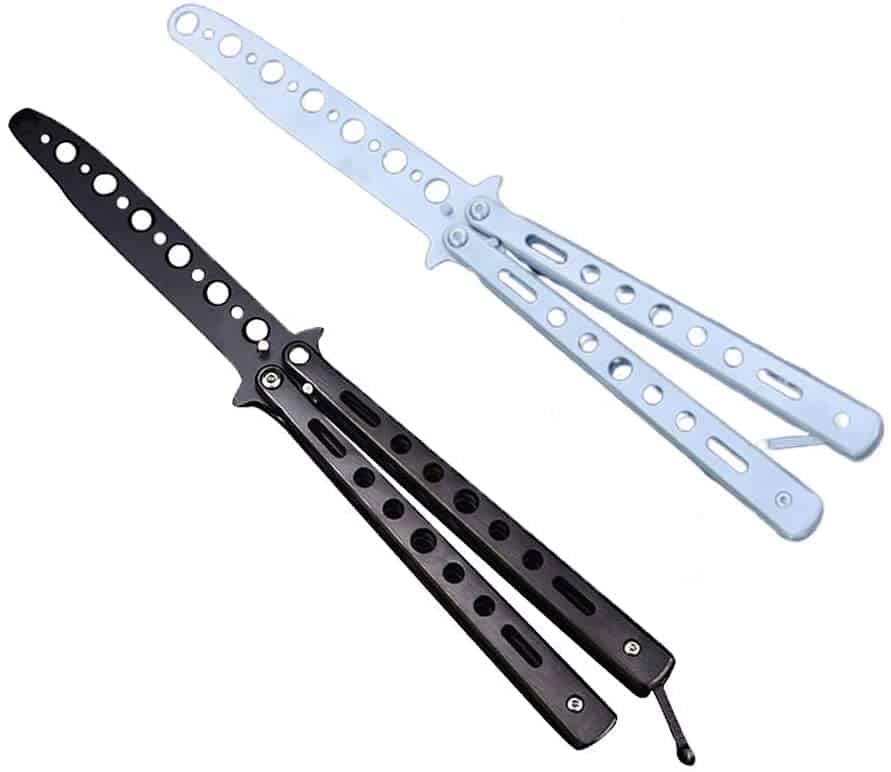
Performing the Basic Twirl trick
The Basic Twirl is one of the most fundamental tricks. This is one of the butterfly knife tricks that can be divided into three movements.
- Open the knife and place your index finger on top again.
- Throw the knife through your index finger.
- Slightly lower the safe handle with your middle finger and after sliding your thumb behind it, give it a sharp push, giving you enough momentum to make a turn.
These movements can be learned by repeating them separately. To look beautiful in the end, you should perform them as one long, continuous gesture.
If done correctly, you can avoid the cutting edge, and this trick won’t affect the fingers at all. All the manipulations are done with the safe grip only. However, one possible critical error in this trick is to take the knife wrong at the very beginning after mixing the handles.
Then, at the beginning of the second movement, the blade might land on the index finger. The result isn’t great. It might require some bandages too. The negative experience is even worse, because it can cause you to completely give up on learning knife tricks. A practiced user might recommend first trying this one out with a butterfly knife trainer.
The second theoretically possible mistake in this trick is that you will somehow magically succeed by closing the knife, placing your fingers on the sharpened side of the blade, and latching the landing handle onto them.
Theoretically possible, but practically difficult. Don’t do it. Use a practice butterfly knife trainer first if you don’t feel confident. With a bit of time, you can move on to a real knife.
The different types of pivots, screws, and rivets
Rivets: Generally used as pivots on the low end or custom balisongs, rivets do not allow tightening with a screwdriver. They can only be tightened with a bull or with hammer blows.
Hexagonal Impression Screws: Hexagonal heads can be found on some balisong knives. If the balisong starts to loosen at the pivots then it can be tightened with an Allen wrench, also called an Allen key.
Torx socket screws: This is used to tighten the screws with higher torque. The Benchmadehas size 8 for the pivots, size 6 for the latch screws. A few years ago, the screwdrivers needed to tighten this type of impression were not available in many places. Now you can find them quite easily at most DIY stores.
For handling, the best thing to have is a tightening pivot system. You may need to examine if you have pivot pins or a tang pin as well. Tightening the rivets with a hammer is only a temporary way to keep your branches attached to the blade.
The abuse of these practices will quickly damage your rivets. Experts often advise that users get knives with a pivot screw system before performing any butterfly knife tricks. As for bladecare, a specialized knife sharpener might be necessary.
Get your butterfly knife and start practicing today!
We hope this article was helpful. Now that you are a real pro at handling the balisong knife or the balisong trainer, all you have to do is choose the right model from one of your favorite knife stores, hopefully ours :), and practice your butterfly knife tricks. Grommet’s Knife and Carry offers you a wide choice of well-made every day carry knives. Get yours today!
 PAY IN FOUR INTEREST-FREE PAYMENTS WITH SEZZLE
PAY IN FOUR INTEREST-FREE PAYMENTS WITH SEZZLE